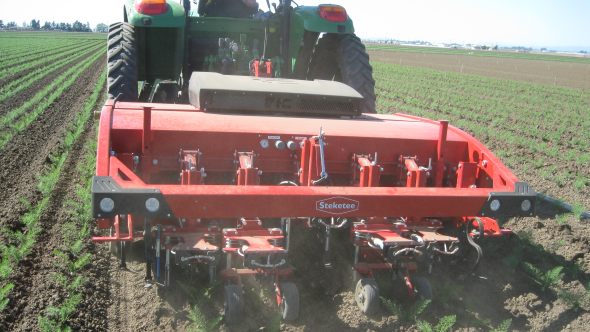When we think of what automated technology can do for us in the future, we think of flying cars, contraptions that help dress us, and being able to call out questions and immediately receive correct answers. What we often overlook, but shouldn’t, are the smaller issues affecting other industries that robotics technology aims to revolutionize. One of these areas, surprisingly, is weeding. Farmers have long been plagued by the need to weed around their crops. A Halifax company has developed technology to combat this problem. But what does Nexus Robotics’ new weeding technology tell us about the future?
Do We Need a Weeding Robot?
After winning an international competition in 2018, Nexus Robotics knew they were onto a winner that would reshape the agriculture industry – literally. The robot, named R2Weed2 or Hal-Bot, uses AI technology to differentiate between pesky weeds and the profitable and necessary crops. Using a combination of plucking and deploying herbicide, the robot is able to tackle a field to speed up the actual work for the farmer and remove one of the main bugbears that the agricultural industry has to face.
<blockquote class=”twitter-tweet”><p lang=”en” dir=”ltr”>Weeding tests begin this week! <a href=”https://t.co/qesVQzDJ73″>pic.twitter.com/qesVQzDJ73</a></p>— Nexus Robotics (@NexusRoboticsCa) <a href=”https://twitter.com/NexusRoboticsCa/status/1042535555798577152?ref_src=twsrc%5Etfw”>September 19, 2018</a></blockquote> <script async src=”https://platform.twitter.com/widgets.js” charset=”utf-8″></script>
The Government of Canada is committed to this tech growth, so has pledged to support businesses that improve the agricultural landscape in this way. As such, the government has offered an investment of $550,000 to Halifax’s Nexus Robotics, a huge coup for the company and for the region’s tech companies. The robot will save the farmers time and help speed up processes, so they can focus on further growth instead of dealing with problems. This isn’t the first boost in the area – 2018 saw a $3 billion investment in agriculture in Nova Scotia.
Canada exports around $56 billion every year through its agricultural output. 90% of Canada’s farmers rely on exports, with 75% of wheat being exported, 90% of canola, and 95% of pulses. The agricultural sector represented around 6% of the country’s GDP and around 10% of its workforce during a study in 2016. Combining the traditional agricultural sector with modern technology represents the future of the industry.
Improving Traditional Industries Through Tech
The mark of the future of technology will be in the ways technology can revolutionize previously traditional industries. As the weeding robot shows a tech solution to a previously analog problem, we can see this approach has already taken off across a number of sectors.
INSERT IMAGE: https://images.pexels.com/photos/4009401/pexels-photo-4009401.jpeg?auto=compress&cs=tinysrgb&dpr=2&w=500 – SOURCE: Pexels
For example, in the entertainment industry, technology has already been deployed across streaming platforms like Netflix to amalgamate data from individual viewers to then begin to suggest to them matches that reflect what viewers like to watch. In other areas of the entertainment sector, as the Betway live casino options for blackjack and poker show, the traditional games have been given a makeover that relies on live streaming technology to allow players to see the dealer in front of them. In hospitality, bars and restaurants, some of the most traditional industries going, now utilize app technology to allow for ordering and payment of food and drink. British pub chain Wetherspoons has utilized an app since 2017 allowing customers to select a table and order food and drink. It also means that people can post messages across social media and have others send them items to their table.
Payment via QR codes have also expedited the restaurant experience. Companies like Deliverect have combined a QR code with the ordering process to allow patrons to scan a code to view a menu. This means they have more of a handle over their experience. By selecting food and drink through technology, they eliminate the potentially time-consuming process. It shows how technology and tradition can work in tandem.
The retail industry is possibly the best example of a traditional industry harnessing the power of technology to provide ways for consumers to be better tended to. Online shopping has risen to a great degree – representing 9.5% of all Canadian retail transactions in 2019. It provides a way for customers to engage with the traditional industry of selecting clothes, while giving them wider scope and an improved experience through online means. As we saw on Quinpool Road, many shops pooled together to create an online experience.
Even the recruitment industry has benefitted from technology to help improve its processes. Prospective job hunters input data and are immediately selected for the next round of interviews or are rejected. This frees up time for consultants to match people with winning jobs quicker, so they can get to more people. While algorithms might not always work, they can help with administrative issues and save time. Indeed, many recruitment processes have begun to be centred around the jobseeker.
The Nexus Robotics weed-plucking robot is not just a huge benefit for Halifax’s tech sphere, but for what it tells us about the future of our interactions with technology. While the government’s investment shows a commitment to streamlining processes with technology, it also shows how analog industries can benefit from technology, without losing the essence. Other applications of technology to previously traditional industries show that there is scope for both to coexist harmoniously to benefit our lives.

